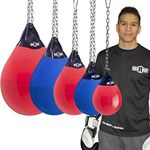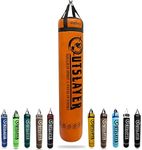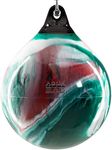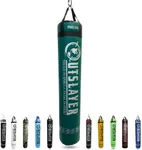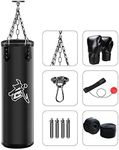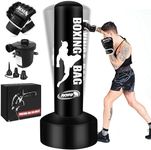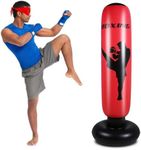Buying Guide for the Best Title Heavy Bags
Choosing the right heavy bag for your training can significantly impact your workout experience and progress. Heavy bags are essential for developing strength, technique, and endurance in various combat sports and fitness routines. To find the best fit for you, it's important to understand the key specifications and how they align with your training needs and goals.WeightThe weight of a heavy bag is crucial because it affects the resistance and stability during your workout. Lighter bags (40-60 lbs) are suitable for beginners, youth, or those focusing on speed and technique. Medium-weight bags (70-100 lbs) are ideal for intermediate users who want a balance between power and speed. Heavier bags (100+ lbs) are best for advanced users looking to develop maximum power and strength. Choose a weight that matches your skill level and training objectives.
MaterialThe material of the heavy bag's outer shell determines its durability and feel. Common materials include synthetic leather, genuine leather, and canvas. Synthetic leather is durable and affordable, making it a popular choice for most users. Genuine leather offers superior durability and a more authentic feel but comes at a higher price. Canvas is less common but can be a good option for those on a budget. Consider how often you will use the bag and your preference for feel when selecting the material.
FillingThe filling of a heavy bag affects its density and impact absorption. Common fillings include sand, fabric, and water. Sand-filled bags are very dense and provide a hard hitting surface, which is great for power training but can be tough on the hands and joints. Fabric-filled bags offer a more forgiving surface, making them suitable for all-around training and reducing the risk of injury. Water-filled bags provide a unique feel and are easy to adjust in weight. Choose a filling based on your training intensity and comfort preference.
SizeThe size of a heavy bag, including its height and diameter, influences the types of strikes you can practice. Shorter bags (3-4 feet) are good for practicing low kicks and punches, while taller bags (5-6 feet) allow for a full range of strikes, including high kicks. The diameter affects the surface area you can strike; wider bags offer more area for punches and kicks, while narrower bags are better for precision training. Select a size that matches your training style and the types of strikes you want to practice.
Mounting OptionsHeavy bags can be mounted in different ways, such as hanging from the ceiling, wall-mounted, or free-standing. Ceiling-mounted bags offer a traditional setup and allow for 360-degree movement around the bag, but require a sturdy ceiling structure. Wall-mounted bags save floor space and are more stable but limit movement around the bag. Free-standing bags are versatile and can be moved easily, making them ideal for home gyms or spaces where permanent installation is not possible. Consider your available space and installation preferences when choosing a mounting option.






